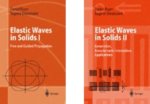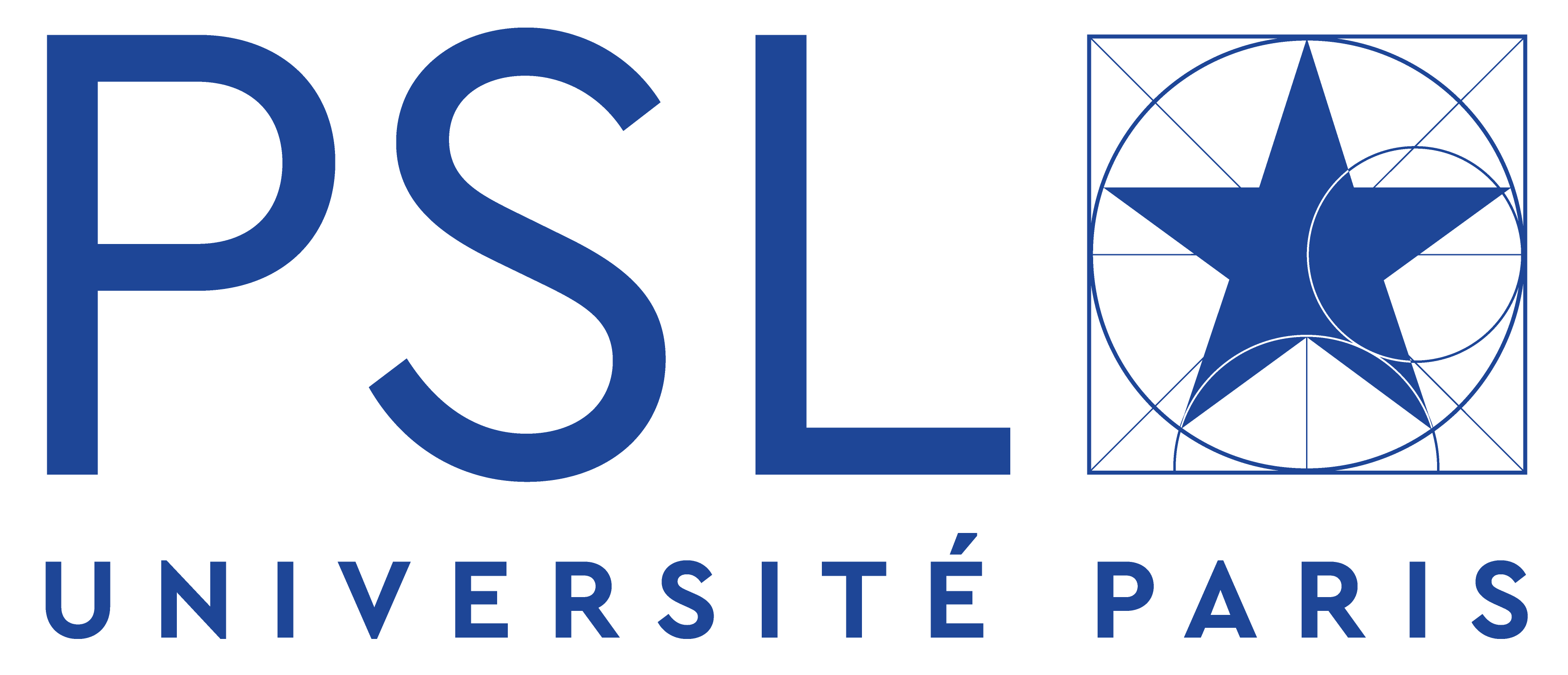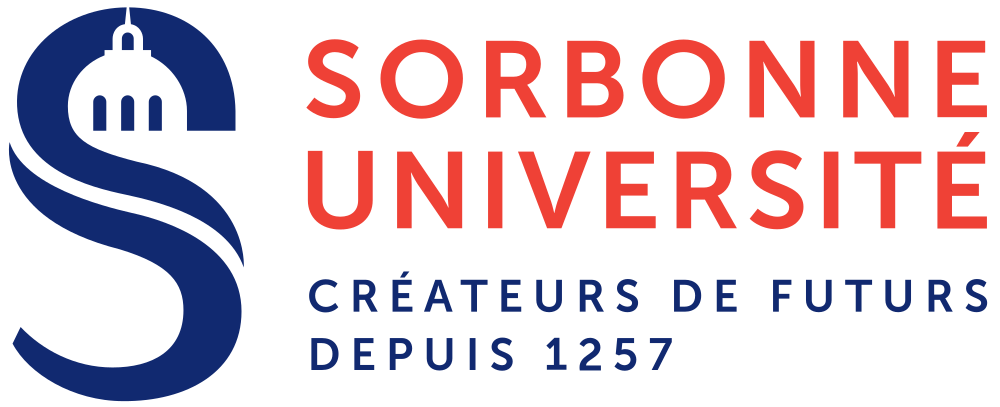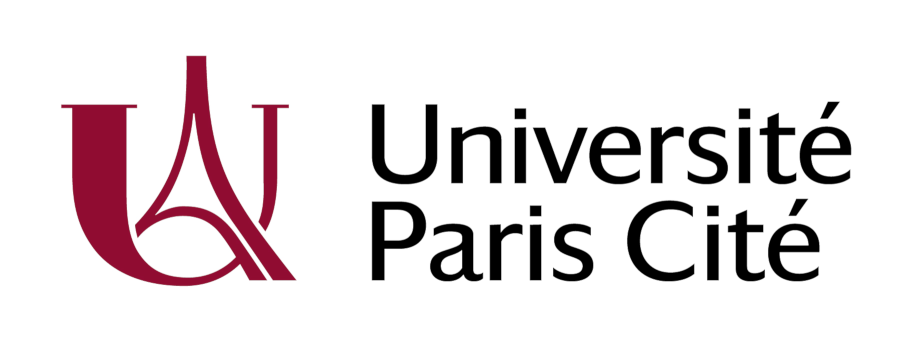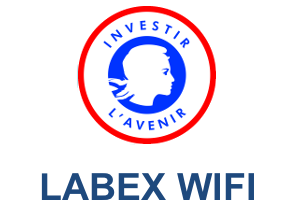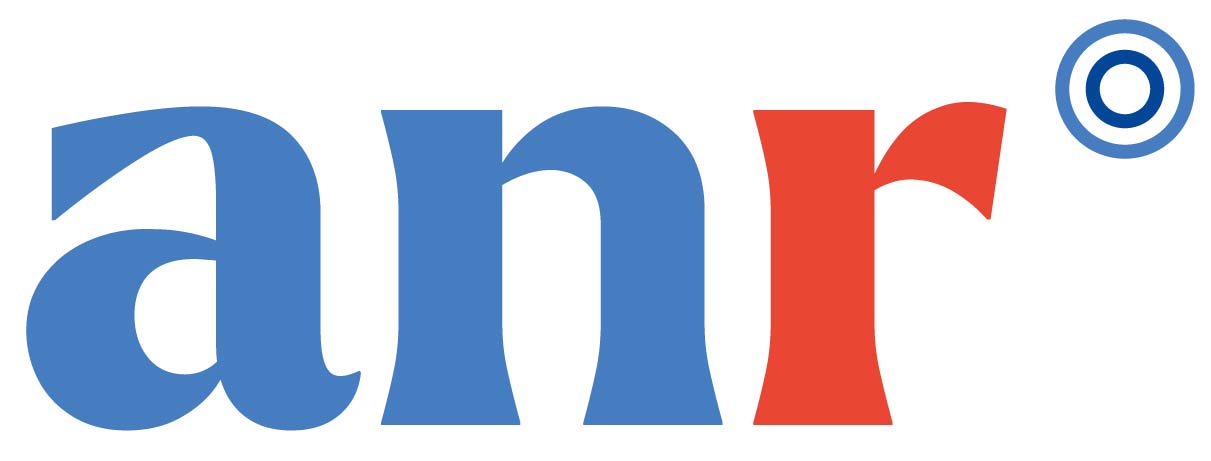Elastic guided waves and laser ultrasonics
Introduction
Conventional methods for nondestructive ultrasonic require either a mechanical contact with the piezoelectric sensor or the immersion of the part to be inspected. The use of a pulsed laser source for generating elastic waves and an interferometer for detecting them removes this constraint. Laser generation is particularly useful in the case of a curved surface on which it is difficult to apply a transducer.
Because of non contact and high spatial and temporal resolution, optical methods are appropriate to study elastic waves propagating in plates and tubes.
1 - Controlling guided waves using negative refraction
Since Mindlin’s work, several studies on elastic waveguides have confirmed the existence of negative phase velocity modes, for which wave fronts propagate in the opposite direction to that of energy. This phenomenon occurs naturally in homogeneous elastic wave guides. We have exploited these modes to make a Veselago lens in an isotropic elastic plate showing negative refraction over a finite width frequency band. We have also studied the negative reflection at the plate edge from S1 mode to S2b mode.
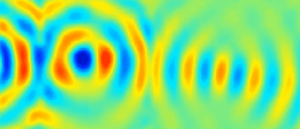

– S. Bramhavar, C. Prada, A. A. Maznev, A. G. Every, T. B. Norris, and T. W. Murray, "Negative refraction and focusing of elastic Lamb waves at an interface", Phys. Rev. B 83, 014106 (2011).
– F. D. Philippe, T. W. Murray, and C. Prada, "Focusing on Plates: Controlling Guided Waves using Negative Refraction", Scientific Reports 5, 11112 (2015)
– G. Gérardin. J. Laurent, C. Prada, and A. Aubry., "Negative reflection of Lamb waves at a free edge: Tunable focusing and mimicking phase conjugation.", J Acoust Soc Am. 140(1):591., (2016)
– D. Forcella, C. Prada, and R. Carminati, "Causality, Nonlocality, and Negative Refraction", Phys. Rev. Lett. 118, 134301, (2017)
– B. Gérardin, J. Laurent, F. Legrand, C. Prada, A. Aubry, "Negative reflection of elastic waves in complex environments, 2017
2 - Zero group velocity guided modes and applications to local material evaluation
Guided elastic waves in plates, cylinders or tubes are highly dispersive and for some modes, the group velocity vanishes. At these particular points of the dispersion curves, called ZGV-modes (Zero-Group Velocity), the frequency x thickness (d=2h) product passes through an extremum while the phase velocity (the wavelength) remains finite. They are therefore associated with local resonances.

In our experiments, these ZGV modes, are generated by a short laser pulse. The mechanical displacement of the plate surface is detected at the same point using an optical interferometer. Once eliminated the contribution due to the air heating, the acoustic signal is dominated by local resonances associated with ZGV modes. First experiments with pulsed laser source were conducted on millimetric metallic plates and wa showed that they allow precise thickness measurement Clorennec et. al. 2006. The temporal decay of these particular resonances have been studied and compared to those of thickness resonances Prada et al. 2008,Laurent et al. 2014.
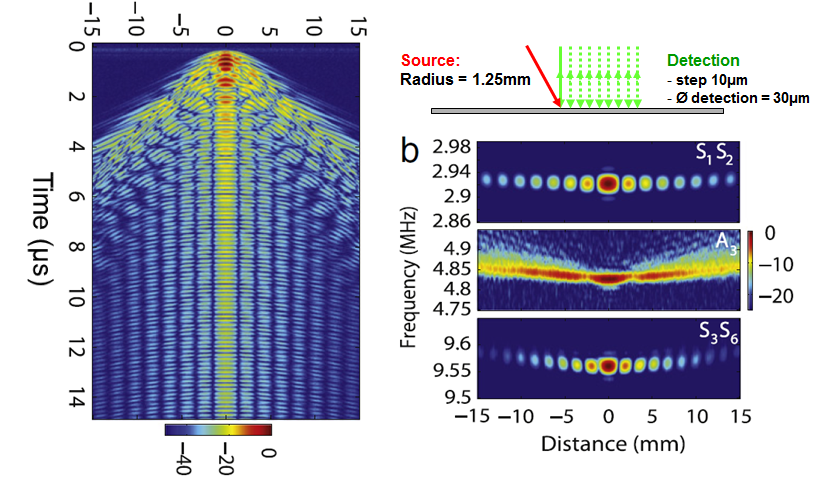
ZGV resonances and non contact Poisson’s ratio measurement
The ratio of the resonance frequencies of the first two ZGV modes is independent of the thickness of the plate and funcion of the Poisson’s ratio. Thus, it is possible to measure locally and precisely the Poisson’s ratio of an isotropic solid plate, and bulk velocities if the thickness is known. This non contact method has been tested on a wide range of materials, plates and shells Clorennec et al. 2007. More generally, we have shown that the spectrum of local vibrations of a plate was entirely governed by the resonances of the ZGV modes. This phenomenon is illustrated below for silica and duralumin plates Prada et al. 2008.
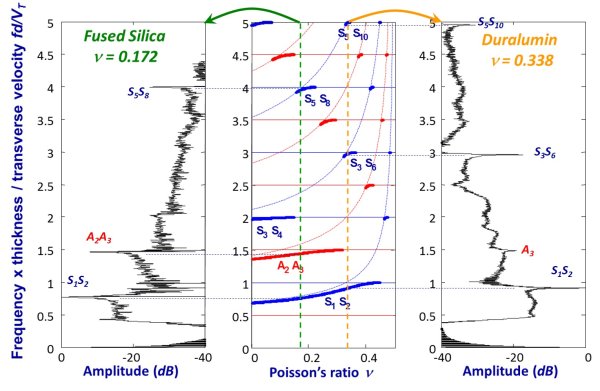
Laser source coupling with ZGV modes : control and optimisation
In metals, we have a surface laser source which couples very well with ZGV modes. We established the expression and experimentally verified the optimal diameter of a Gaussian beam to generate the ZGV modes. In addition, a axicon lens system has been adapted to produce an annular source of controlled diameter and width, in order to increase the ZGV amplitude resonances, remaining below the ablation threshold Bruno et al. 2016.
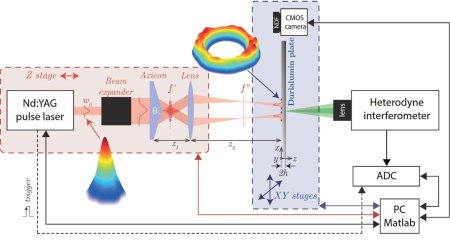
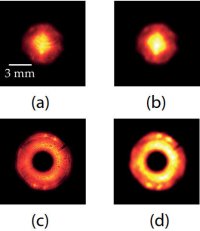
We have studied the generation of ZGV resonances in plates of low optical absorption. In that case, we have a volume source, the amplitude of the generated ZGV modes depends on the incidence angle of laser and optical penetration length Raetz et al.2015.
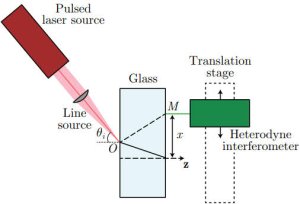
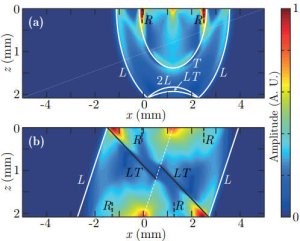
ZGV modes in anisotropic materials
In anisotropic plates, dispersion curves and their frequency minima depend on the direction of propagation. For example, on a silicon wafer and with a point laser source, two ZGV resonances are excited in the vicinity of the thickness resonance. Using a line source to select a propagation direction, we observed a single ZGV resonance whose frequency and amplitude vary with the direction of the source. Clorennec et al.. These observations open the way for non-contact measurement of the anisotropy of composite materials or metallic plates obtained by rolling.
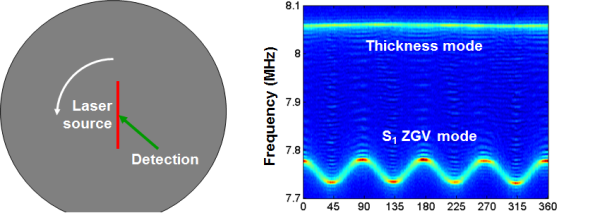
We followed the same approach to measure the anisotropy of Zircaloy tubes used for fuel cladding in pressurized water reactors. Material properties of Zircaloy need to be evaluated to improve ultrasonic inspection of these tubes. Recent ultrasonic studies showed that this material is anisotropic. Assuming a transverse isotropic medium we calculated the dispersion curves of axial and circumferential Lamb waves. Measuring the spectrum of ZGV resonances, we were able to estimate the five elastic constants of the material Cès et al. 2012.
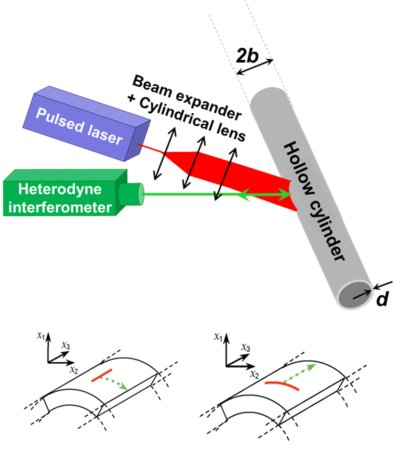
Finally, we have put in evidence the numerous ZGV modes in cylinders. We measured the associated resonances in sub-millimeter diameter metallic wires and used them to determine the elastic constants Laurent et al. 2015.
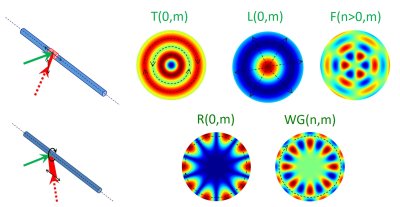

ZGV modes in bonded plates
Zero Group Velocity (ZGV) Lamb modes can be used to evaluate the coupling between two solid plates bound by a thin layer. If the thickness of is negligible, the coupling can be modeled by normal and tangential interfacial stiffnesses. We have shown for a symmetric bilayer structure, that the ZGV resonance frequencies were a function of these interfacial stiffnesses.
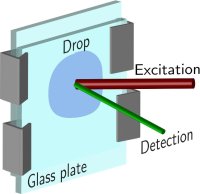
Zero-Group Velocity (ZGV) Lamb waves are studied in a structure composed of two plates bonded by an adhesive layer. The dispersion curves are calculated for a Duralumin/epoxy/Duralumin sample, where the adhesion is modeled by a normal and a tangential spring at both interfaces. Several ZGV modes are identified and their frequency dependence on interfacial stiffnesses and on the bonding layer thickness are numerically studied. Then, experiments achieved with laser ultrasonic techniques are presented. Local resonances are measured using superimposed source and probe. Knowing the thicknesses and elastic constants of the Duralumin and epoxy layers, the comparison between theoretical and experimental ZGV resonances leads to an evaluation of the interfacial stiffnesses. A good agreement with theoretical dispersion curves confirms the identification of the resonances and the parameter estimations. This non-contact technique is promising for the local evaluation of bonded structures.

ZGV modes and Detection and characterization of thin films
We studied the influence of the deposit of a thin film ( 100 nm) on the ZGV resonances of a millimeter thick plate. The theoretical study has shown that the frequency behavior was significantly different from that of a quartz resonator for which a layer produces a relative resonance frequency shift equal and opposite to the relative mass variation. Numerical simulations show that the S1 ZGV resonance frequency varies as :
The proportionality factor K is dependent on both the substrate and the layer. K values can be very different from unity, for example, K = 1.16 for gold deposited on Duralumin, K = 0.3 for silicon carbide deposited on Duralumin, and even K = -0.48 for silicon carbide deposited on copper. Theoretically, the deposit of a thin layer can increase the resonant frequency. However, this has not been experimentally verified.
The thickness of 100 nm to 500 nm thick gold films deposited on a Duralumin plate, was estimated from the opposite side Cès et al. 2011 .

Edges Modes and ZGV Modes
Zero group velocity modes are special solutions of the Rayleigh-Lamb equation for an infinite plate. In practice, it is important to study phenomena occurring near the edges in order to understand the factors that limit the application of ZGV methods. We have experimentally observed on different materials, an abrupt transition between S1 mode ZGV resonance and edge resonance that appears at a frequency significantly lower. The figure below shows the measured resonance spectrum of a Duralumin plate for different distances between the source and the plate edge. It is observed that this transition occurs at a distance from the edge equal to the plate thickness. Cès et al. 2011.

Publications on zero group velocity guided modes :
– Prada C, Balogun O, Murray TW, Laser-based ultrasonic generation and detection of zero-group velocity Lamb waves in thin plates, Appl. Phys. Lett. 87 (19): 2005.
– Clorennec D, Prada C, Royer D, Laser impulse generation and interferometer detection of zero group velocity Lamb mode resonance, Appl. Phys. Lett. 89 (2): 2006.
– Clorennec D, Prada C, Royer D, Local and noncontact measurements of bulk acoustic wave velocities in thin isotropic plates and shells using zero group velocity Lamb modes, J. Appl. Phys. 101 (3): 2007.
– Prada C, Clorennec D, Royer D, Power law decay of zero group velocity Lamb modes, Wave Motion 45 (6), 2008.
– Prada C, Clorennec D, Royer D, Local vibration of an elastic plate and zero-group velocity Lamb modes, J. Acoust. Soc. Am. 124 (1), 2008.
– Royer D, Clorennec D, Prada C, Caractérisation de plaques et de tubes par modes de Lamb à vitesse de groupe nulle, Instrumentation Mesure Métrologie, Vol 10/1-2, pp.73-94, 2010
– M. Cès, D. Clorennec, D. Royer, C. Prada, Edge resonance and Zero Group Velocity Lamb modes in a free elastic plate, J. Acoust. Soc. Am. 130, 2, pp. 689-694 (2011). JASA_2011
– M. Cès, D. Clorennec, D. Royer, C. Prada, Thin layer thickness measurements by Zero Group Velocity Lamb mode resonances, Rev. Sci. Instr. 82, 114902 (2011).
– M. Cès, D. Royer, C. Prada, Characterization of mechanical properties of a hollow cylinder with zero group velocity Lamb modes, J. Acoust. Soc. Am. 132 (1), (2012)
– J. Laurent, D. Royer, C. Prada, Temporal behavior of local plate resonances, Wave Motion 51 (6), pp 1011–1020, (2014)
– S. Mezil, J. Laurent, D. Royer, C. Prada, "Non-contact probing of interfacial stiffnesses between two plates by zero-group velocity Lamb modes", Appl. Phys. Lett. 105, 021605 (2014).
– S. Mezil, F. Bruno, S. Raetz, J. Laurent, D. Royer and C. Prada, "Investigation of interfacial stiffnesses of a tri-layer using Zero-Group Velocity Lamb modes" J. Acoust. Soc. Am. 138 (5), 3202-3209 (2015).
– J. Laurent, D. Royer, T. Hussain, F. Ahmad, C. Prada, Laser induced Zero-Group Velocity resonances in Transversely Isotropic cylinder, J. Acoust. Soc. Am. 137 (6), (2015).
– F. Bruno, J. Laurent, P. Jehanno, D. Royer, C. Prada, "Laser beam shaping for enhanced Zero-Group Velocity Lamb modes generation", J. Acoust. Soc. Am. 140 (4), 2829-2838 (2016).
– S Raetz, J Laurent, T Dehoux, D Royer, B Audoin, C Prada, "Effect of light refraction on the photoelastic generation of ZGV Lamb modes in optically low-absorbing plates", J. Acoust. Soc. Am. 138 (6), 3522-3530 (2016)
